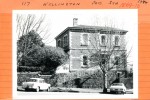Vernon
Cliveden, 192 Wellington Parade, East Melbourne - 1887
Scanned copy of wood engraving of proposed residence of Sir W.J. Clarke on the corner of Wellington Parade and Clarendon Streets, East Melbourne. The building is described as "Italian Renaissance style, large private residence on corner of Clarendon St. and Wellington Pde; Mr. S. Armstrong, builder; Messrs. Wardell and Vernon, architects."
- 7822 reads
Jolimont, Wellington Parade South 117 - Burchett
1869. MCC BR: Anton Schultz to build dwelling house for the Misses Vernon. Site named as Jolimont Square.
1870. Mrs. (John) Vernon - owner/occupier. Brick, 3 floors and 12 rooms.
1900. Mrs. F. Ball - occupier.
- 3208 reads
Jolimont, Wellington Parade South 117, Mornington
Large 3-storey house built of polychrome brick
As is well known Jolimont was once the home of lieutenant-governor Charles Joseph Latrobe, purchased by him in 1839. When he returned to England in 1854 he left his friend, Dr James Palmer, in charge of subdividing and selling his land. Palmer kept for himself the central part of the property, which became known as Jolimont Square. On it he built five large, two-storey, timber



